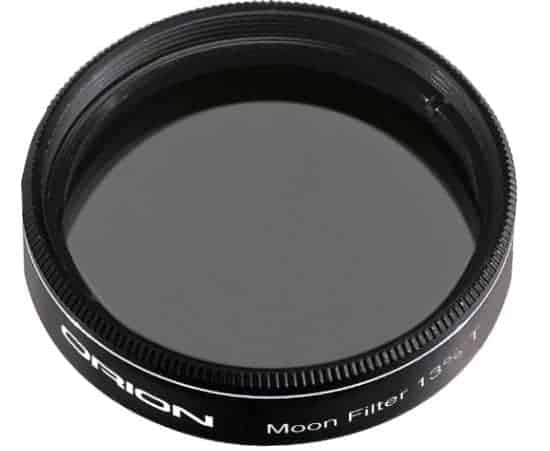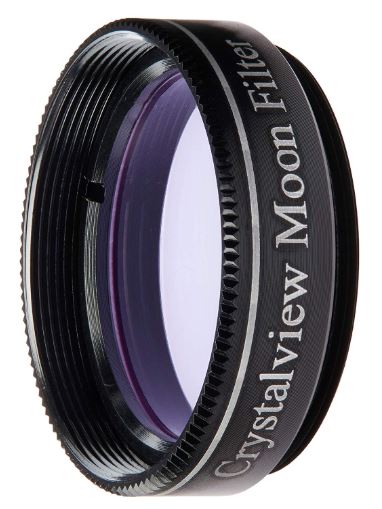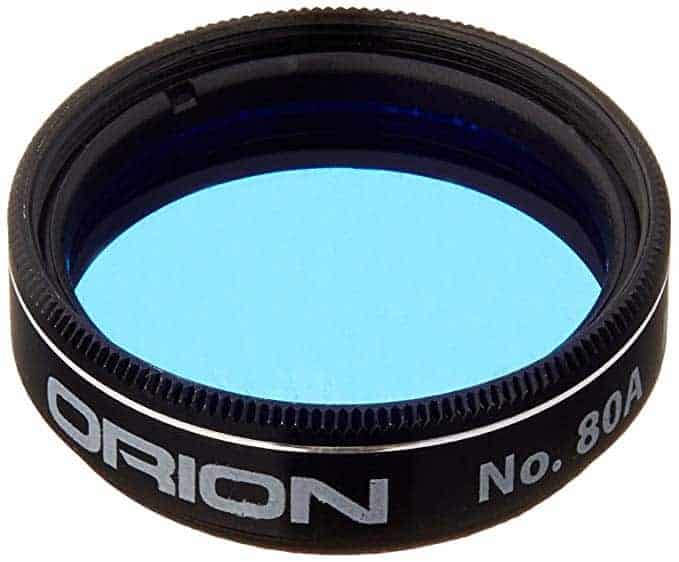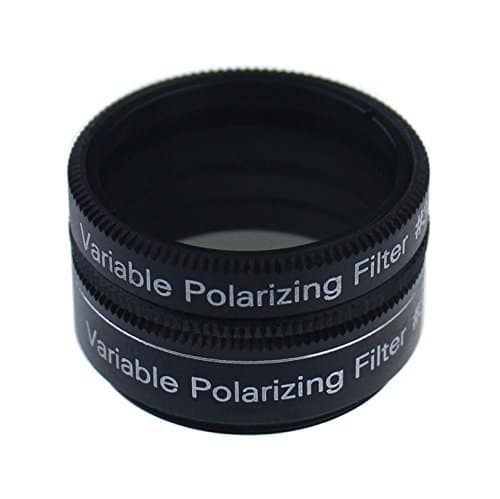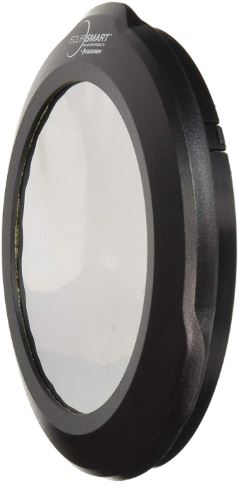Astronomy can be a worthwhile and intellectual hobby for any beginner to the “professional amateur”. However, there will be instances when you will experience problems with getting a clear and vivid view of a celestial object. Here are the top 5 filter types any astronomer should own.
Top 5 Recommended Filters You Should Own and Why
- Moon Filter: (like sunglasses) reduces white light allowing for clearer view.
- Light Pollution Filter: Cuts out the spectrums of light radiating from a city.
- Light Blue Filter: Improves planetary viewing and brighter galaxies.
- Narrow Band Filter: Nebula viewing allows certain colors and darkens the sky.
- Aperture Solar Filter: Reduces the sun’s rays protecting eyes and telescope.
For more detail on the type and darkness of the filter that best fits your need, you should read to the end.
I also have specific recommended Filters that I used and have found to be rated good to awesome. They were picked for the improvement they gave for there entry level prices.
How Do You Pick What’s Best For Your Need?
Astronomy can be a worthwhile and intellectual hobby for a beginner to the professional. However, there will be instances when you will experience problems with getting a clear and vivid view of a celestial object.
To solve this, telescope filters are used to make the whole experience more breath-taking and worthwhile. There are various filters in the market and each has a respective function they do.
Why Do We Use Filters for a Telescope
Viewing a more vivid and detailed image of any celestial body is a typical challenge for any astronomers, may it be an amateur or professional. This scenario makes telescope filters a necessity rather than a mere accessory for any telescope.
In general, they filter out unwanted, or enhance weak colors in the spectrum to allow a better view.
Factors Affecting View Quality
Say, for example, your scope is of great quality and everything has been well-maintained, but still you cannot see any real details of the moon. There are uncontrollable things in the environment which greatly affect the quality of image you see through your telescope.
For instance, light pollution in or near a city produces light from street lights, like sodium vapor lamps, car headlights, and security lights. These lights create excess glaring effect which hinders your chance of getting a clearer view of the sky.
This is like when your dome light is on inside your car while driving at night.
The second factor affecting the quality of the image seen through your telescope is air pollution. The smog and dust particles in the sky during the day are there at night too. This can cause blurry fuzzy images looking through the scope. In order to minimize this, you need to pick a good spot, far enough away from the city or possibly in a higher altitude than the city to get a cleaner more clear view.
Another factor is the condition of the atmosphere. Humidity and wind shear can be present high up in the night sky still even long after the sun has set. While filters may not help to much with Mother Nature, sometimes reducing a the visible band can reduce the rainbow effect let’s say of the moisture in the sky.
Types of Telescope Filters
In the market, there are several types of scope filters with varying function for you to choose from. Some of these types are color filters, Narrowband filters, line filters, broadband filters, for light pollution, chromatic aberration filters, and solar filters.
Narrowband Filters
These kinds of filters are best used for deep space observation and the viewing of nebulae. Some of the specific celestial objects better viewed using this filter include the Swan Nebula, Lagoon Nebula, and the Orion Nebula.
Narrowband filters work by only allowing Oxygen III and Hydrogen Beta spectral emissions to pass through. Likewise, in order to improve contrast for celestial objects that are faint objects, this filter dims the background, or blackens the sky without jeopardizing the image quality of the object.
Further, if you are in a place with a moderate level of air pollution, this filter still works fairly well. Even with a medium level of magnification, this filter will never fail you and provide a good image of nebulae like Orion.
Line Filters
Also called Ultra High Contrast Filters are In comparison with the narrowband filter, line filters have a narrow slit which only allows a single type of emission line to pass through – either Oxygen III or Hydrogen Beta only.
If you aim to observe a nebula with a diffused emission or a planetary nebula, then choose an OIII filter which permits the transmission of the Oxygen III lines only.
Meanwhile, if you aim to observe brighter nebula, then choose a Hydrogen-Beta (H-Beta) filter. However, if you plan to view a nebula with low brightness or a higher number in magnitude object, use this filter with a telescope having a larger aperture.
Oftentimes, this filter is not that suitable when viewing planetary nebula. Some of the celestial objects best viewed using this filter are Cocoon nebula, M42, M43, California nebula, North American Nebula, and the famous Horsehead nebula.
Filters for Light Pollution
Light pollution is a common problem for avid astronomers who observe the night sky from the comfort of their backyard especially in the urban area. Lights coming from vehicles, street lights, and traffic signals are a big contributor to light pollution.
This issue can still be felt for people living slightly away from the city. In order to resolve this issue, you can use the LPR filters or the Broadband Light Pollution Reduction filters.
How does it work?
It definitely improves the clarity and contrast of celestial objects by inhibiting the transmission of sodium, mercury, and other color light typically emitted from the fore mentioned things.
Solar Filters
If you want to observe and view the sun, then you definitely need to use a solar filter in order to avoid damaging your eyes. The best filter in my opinion is the whole aperture solar filter. This filter is typically placed in front of the scope’s primary objective lens, or opening and placed so the filter protects the whole telescope, not just your eyes. the strong UV rays of the sun can heat and distort your scope easily. It is like when you hold a magnifying glass up in the sun, but most times more powerful.
NOTE: Never use your telescope to look at the sun unless using this whole aperture filter. I would still test it with a projection image before viewing.
Never use solar eyepieces because the intense suns energy could cause extreme fast heating and the eyepiece shatter.
A good quality solar filter is able to effectively block 99.99 percent of sunlight transmission towards the eyepiece of the observer. Just be safe! You need your eyes to see the universe.
Chromatic Aberration Filters
It is typical that lenses experience chromatic aberration or splitting of light that causes slight rainbow formations. This condition eventually hampers the effectiveness of viewing objects with your lenses.
Consequently, to resolve this concern, there are chromatic aberration filters which will mitigate the intensity of occurrence.
Color Filters
As the name suggests, these filters help block and allow specific color lines or bands to be transmitted for viewing. Further, this type of filter is commonly used when viewing planets in the solar system.
There is an array of filters under this type which is organized using the Wratten System. The name of this system was derived from its inventor Frederick Wratten.
This system label filters using a number followed by a letter.
What Do The Numbers Mean?
In the field of astronomy, photography, and optics, optical filters are labeled and categorized using the Wratten System. This system provides a specific code comprising of a number followed by a letter for a specific filter.
The number in the code refers to the filter’s color but is assigned in a random pattern compared to a box of Crayola Crayons. Meanwhile, the letters correspond to color strength which typically increases as the letter increases. The higher the strength the more light that is filtered.
Frederick Wratten and his partner Mees sold their Wratten filters to Eastman Kodak in 1912. These filters are typically used by all amateurs in the field of observational astronomy. However, if you will be doing Digital imaging, you need to use an interference filter.
With the evolution of technology, digital photography came into existence. The adjustments for the color and temperature of the image can already be done using software incorporated inside the software. This innovation slowly removes the application of these filters in traditional photography, but astrophotography is a whole other story.
How to Use a Telescope Filter
Using a telescope filter is straightforward and quick. The more pressing issue is on how to choose which filter to use for specific situations.
To further guide you about this, here are some important tips and tricks with details on using telescope filters.
Does Size Matter?
Definitely, the size of the scope’s aperture matters. If you have a smaller aperture, then you need to use a filter with the higher visible light transmission (VLT).
For scopes with an aperture size smaller than 6 inches or 150 millimeters, you should use a VLT higher than 40 percent.
Visible light transmission is compounded when stacking telescope filters.
How to Install the Filter?
Telescope filter can be stacked together when used simultaneously. To install it, you need to first remove the eyepiece of your telescope.
Then, at the bottom of the barrel of your eyepiece, thread the filter to fit inside. Next, place the eyepiece back in the scope and now you’re ready to view.
Most Common Colors and their uses
We are done discussing the different types of filters available on the market for astronomy. Now, let us look at some of the most common color filters used in observational astronomy along with their corresponding usage.
#82A Light Blue
- Visible light transmission (VLT) is 73 percent
- Works parallel as the #80A Blue
- It can be used to view Mars, Saturn, Moon, and Jupiter
- Considered as an excellent all-purpose filter
- Frequent option for viewing bright galaxies
#80A Blue
- Best for viewing details of Mars’ atmosphere
- Saturns’ belts and polar areas
- A frequent choice for getting good contrast with the moon
- Best in getting a vivid image of the binary star Antares
ND96 Neutral Density
- Great in allowing uniform transmission of all sorts of light
- Sufficient glare reduction
- One of the best choice for moon observation
- Excellent choice as well for split view with double stars
#58 Green
- Allows 24 percent transmission of visible light
- Ideal for getting a better contrast with the lighter areas of Jupiter
- The atmosphere of Venus and Mars’ polar regions
- Saturn’s belts and polar areas
#56 Light Green
- Allows 53 percent transmission of visible light
- A better view of Mars’ polar regions and atmosphere
- Belt of Saturn
- Jupiter’s polar areas
- General observation of the moon
#47 Violet
- Allows 3 percent transmission of visible light
- Ideal when using telescopes with large apertures
- Filters yellow, red, and green light emissions
- Also considered as an excellent all-purpose filter
- An excellent choice for viewing Venus
- Viewing ice caps of Mars
- Jupiter’s atmosphere
#38A Dark Blue
- Allows 17 percent transmission of visible light
- Viewing features of Mars such as dust storms and polar regions
- One of the ideal choice for getting a good contrast when viewing Saturn, Jupiter, and Venus
#25A Red
- Allows 14 percent transmission of visible light
- The best filter to get a great contrast with the features and atmosphere of Mars
- Excellent glare reduction when observing Venus
- Ideal when using telescopes with large apertures to view the clouds and features of Jupiter
#23A Light Red
- Allows 25 percent transmission of visible light
- Great in getting a vivid image of the Maria on Mars
- A better view of Jupiter’s belts and polar areas
- A better view of the polar areas and rings of Saturn
#21 Orange
- Allows 46 percent transmission of visible light
- Great Red Spot and belts of Jupiter
- Effective filter for green and blue light
- Effective contrast between red, orange, yellow, and green, blue
- One of the best choice for viewing Mars
#12 Yellow
- Allows 74 percent transmission of visible light
- Ice caps and clouds of Mars
- Increases contrast of Saturn and Jupiter’s orange and red areas
#11 Yellow Green
- Allows 78 percent transmission of visible light
- Best when used with large apertures for getting a better detail of Uranus and Neptune
- Enhances contrast of Maria on Mars
- Enhances the dark regions of Saturn and Jupiter
#8 Light Yellow
- Allows 83 percent transmission of visible light
- Enhances the details of Maria found in Mars
- Emphasizes the red and orange areas of Jupiter
- When used with larger apertures, you can clearly view the details of Neptune and Uranus
FREE Chart Available for Quick Referencing Best Filter for Planet Views
We have a quick chart that references for you the color filter and its advantage for each planet up to Saturn. We figure if you are looking for Neptune and Uranus, you probably know what you are doing.
Just click here to view and download the chart!
The Best First Filters to Invest In?
Investing in the right telescope filters takes much of your time looking into all the different factors and features for each type. Likewise, the presence of numerous options makes the process more complicated and when the budget is a strong factor. IF you don’t believe me that it is complicated, just click this Amazon link … Astronomy Filters.
In order to ease your burden a little, these are my suggestions below for some good quality affordable filters that you can invest in based on your astronomy adventures. They should improve your viewing, and keep some of your wallet intact.
Best for Overall Moon Filter
Orion 05662 1.25-Inch 13 Percent VLT Moon Filter (Black)
This one is our top pick for the best filter you can invest in your first astronomy venture. The overall features you will have for this filter is more than satisfactory when compared with its performance and price.
Looking at its specifications, it can fit in a 1.25-inch eyepiece barrel and allows 13 percent of visible light to pass through. If effectively minimizes the glare of the moon which helps you observe its features and regions for as long as you want.
Another benefit worth taking for this filter is that it does not alter the original color of the celestial body or the moon for instance. This is very friendly and affordable for those starting out in their observational astronomy hobby.
Best Light Pollution Reduction Filter
Gosky 1.25 Inch Telescope Filter
The second filter in our list is best for its feature of effectively removing light pollution to enhance viewing of the moon and other celestial bodies. This filter is one of the best options for viewing the night sky near a city.
Most people think that filters are unnecessary and a mere add-on cost for your astronomy adventure. Definitely, it is an add-on cost but a worthy investment if you want to get a cleaner crisp view and better contrast of celestial bodies.
When viewing through the eyepiece without the filter, typically what you would see is a flood of light coming from a round object. However, with a filter, you would enjoy the details of the craters and the rough surface of the moon.
Moreover, this filter sharply improves looking for more dim objects by blocking most of the unwanted city glow.
Best All Round Blue Filter
Orion 5188 1.25-inch Planet Eyepiece Filter
Third, in our list, is a telescope filter which works as well at enhancing the most things out there that you can see with a typical amateur scope. Never underestimate this filter as its ability to bring detail that you could not otherwise see.
This filter provides better contrast and details of planetary viewing overall. It is the best one to start out with. Allowing 29% light transmission it may be too strong for your size telescope.
You may want to look at an 82A with smaller size scopes which allows about 73% transmission.
Any blue filter will enhance your views of the planets. You just have to pick the one that will suit your size telescope and allowing light to pass through. Remember, the bigger the diameter of the telescope, the more light will reach the eyepiece. So the 82A lighter blue for the smaller scopes work best.
.
Best for Variable Polarization
Celestron 94107 Variable Polarizing Filter
The best feature from this filter is its variable polarization ability. This is great in order to have better customization when viewing for various light and dark conditions in the sky.
It is tiresome to find the right spot for viewing the sky when the amount of light transmitted through the eyepiece cannot be controlled. For this one, you can do smooth adjustments of light transmitted from 1 to 40 percent through the rotation of the eyepiece’s housing.
The convenience you get from the smooth adjustment of light transmission and the overall housing of the filter is a good trade-off for its price.
When using a Barlow lens you can put one piece of the filter on the Barlow, and the other on the eyepiece so not to have to remove the eyepiece to adjust the filter.
Best for Solar Filter
For someone starting out in observational astronomy, they probably want to look at the sun at some point. Like when there is talk of sun spots, flares, or an eclipse coming. The filter pictured provides an excellent solar filter at an affordable price. Its solar polarization ability has passed the ISO standard which ensures you safe viewing of solar eclipse and others.
The problem is you have to buy the correct size whole aperture solar filter. This is also why I recommend the polymer sheets where you can create your own end cap to block the sunlight.
When using aperture filters, you are assured of having a cooler and detailed image view of the sun. More on Solar viewing in this article…
If you can find your size, in a brand name manufacturer consider adhering Velcro straps to the filter to provide you with a more secure fit of the filter. Moreover, buying solar film you could make your own. Look for film manufactured by the American Paper Optics who is one of the credible suppliers of NASA.
Need More?
Hopefully, the above has provided you with enough information and tips about telescope filters where you feel informed enough to buy your first one and enhance your views.
For further questions, comment, or suggestions, please feel free to contact us anytime and we will do our best to answer your question as quickly as possible.
I have other related articles you may find worthy, like:
What a Barlow Lens Means and Does for Your Telescope
Will Montgomery shares field-tested filter tips from real nights under the stars — plus how color filters helped him level up his lunar and planetary views.



